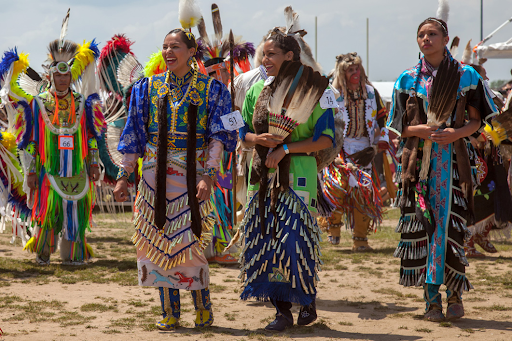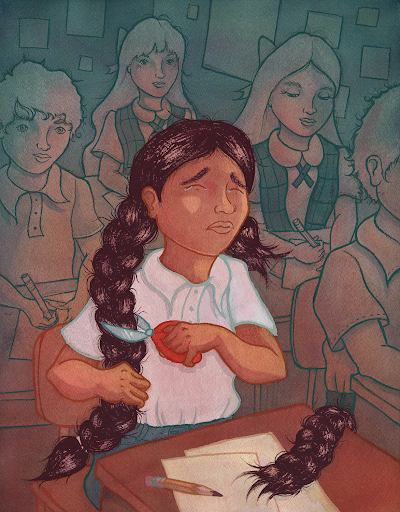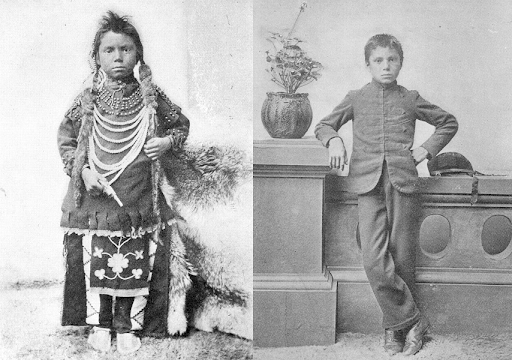Beauty of the Indigenous Culture Instilled from Birth (Hille n.d)
By: Stephie Lee Varghese
***This article contains content mentioning abuse which may be triggering for some.
There is an undefined beauty that can be found within the peaceful culture and traditions of the Indigenous community.
According to the British North American Act, Indian Act and Constitution Act, there are three distinguishable groups of Indigenous People. This includes the First Nation, Métis and Inuit. Each group is rich with various traditions, customs and beliefs.
The Indigenous People have creation stories that vary from each community. These stories serve as a lesson about the environment, mankind and the heavens. Many of these stories consist of beings with superhuman powers that helped create the world.
According to the Canadian Museum of History, “in the stories told by different Aboriginal peoples across Canada, Sky Woman, Glooscap, Sedna, Nanabush or Raven create the world, or change it into the world known to human beings. Over the centuries, we have told these stories, sung them, carved them, painted them, and brought them to life through objects and dance” (Canadian Museum of History n.d).
Moreover, according to Statistics Canada, “the Aboriginal languages spoken by the largest number of First Nations people were Cree languages, Ojibway, Oji‑Cree, Dene and Montagnais” (Statistics Canada 2017). The Métis spoke in Michif and the Inuit spoke in Inuktitut.
The Indigenous People acquire food through hunting and fishing. They eat food such as berries, wild meats, fish, bird and plant species. The Indigenous People have a deep connection with the food they eat as it contributes to their cultural and spiritual identity.

Powwow Dance Festival (Simpson 2016)
The Indigenous People also have a love for music and dance.
The First Nations People used instruments such as drums and rattles. These instruments created music that would be played during their dances. They had Powwow dances to entertain and tell important stories about history. These dances were performed by men, women and children.
The Métis embraced violins as Europeans brought them to North America. They created their own rhythms and tunes which led to the creation of various dances such as the Red River Jig. Moreover, they were widely known for square dancing and sometimes danced into the morning.
The Inuit have a vocal style of singing known as katajjaq or throat-singing. Their music is centred around drums which they use in dancing and storytelling. They have weaved their acrobatic skills into their dance routines and formed groups such as the Clyde River Hip Hoppers.
The Indigenous People are rooted in their beliefs. They have various traditions that tell stories of the past with a deeper meaning which may not be visible to the naked eye.

Destruction of the Indigenous Culture (Tumblr n.d)
However, their beliefs and traditions had been disrupted by many events, one of them being residential schools.
Residential schools were created to assimilate Indigenous children into society. These schools were operated by Roman Catholic and Anglican churches as many people believed that Christianity and civilization were closely knitted together.
Instead of providing a safe space for the Indigenous children, residential schools had driven families apart and left a feeling of hopelessness in the minds of many young children.
Upon arriving at the residential schools, they were given new uniforms and haircuts. To many Indigenous people, their braids represented their culture and identity. Moreover, some believed that their braids represented their family. Losing those braids could have led the children to believe that their parents had passed away.
Additionally, they were not allowed to speak in their native languages. Their Indigenous names were replaced with numbers, dehumanizing them further. Many of them were forced to leave their former lives of tranquility, only to enter into a place that would put them through unendurable torture.
The boys and girls were separated in residential schools. The girls were in charge of housekeeping where they were taught to do laundry, sewing, cooking and cleaning. The boys were in charge of maintenance and agriculture where they were taught carpentry, tinsmithing and farming.
There was not enough food for all the children due to overcrowded residential schools. Often, the food that was being served was poor in quality as well. This made many children vulnerable to diseases such as measles, typhoid, diphtheria, pneumonia, tuberculosis and influenza.
In addition, the Indigenous children were emotionally, mentally, physically and sexually abused. “Survivors recall being beaten and strapped; some students were shackled to their beds; some had needles shoved in their tongues for speaking their native languages” (Hanson 2009).
All these incidents have left a void in the lives of many survivors, a piece of their humanity ripped away from them as children. They were left to handle the feeling of abandonment all on their own, they had no one to turn to.

The Loss of An Identity (Facing History & Ourselves n.d)
Residential schools had forced Indigenous children to hide their true identity. Keeping their identity hidden meant concealing the most meaningful parts of their culture.
These schools have left a huge scar on the Indigenous community. “...the Truth and Reconciliation Commission released its final report on the institutions that lasted over 100 years and caused irreparable harm to First Nations people and families. Those affects include high rates of addiction, abuse, violence, illness and death. Affects that are now only being connected to the schools'' (Deerchild 2015).
Furthermore, residential schools have had a major impact on the present youth of the Indigenous community. They were robbed of any chance for the Indigenous culture to be passed down to them. Instead now, their history includes the bloodshed, cries and sufferings of many innocent lives.
However, residential school survivors such as Phyllis Webstad who wrote Orange Shirt Story and Phyllis' Orange Shirt continue to share their experiences in order to bring light to the situation and move forward.
In essence, the rich culture of the Indigenous People has a deep meaning which sometimes can be beyond the comprehension of an average human being outside of the community.
The establishment of residentials schools has left a huge tear in the Indigenous community that has yet to be mended. As the future leading generation, stitching this hole back together is a major responsibility that needs to be fulfilled.
Albus Dumbledore once said, “...we are only as strong as we are united, as weak as we are divided...Differences of habit and language are nothing at all if our aims are identical and our hearts are open” (Rowling 608).
In the end, the main goal is to function as a well working society. This can only be achieved through reconciliation with the Indigenous community and by taking action. They deserve a life where they are free to express their true identity and embrace their culture.
Works Cited
“The Aboriginal Languages of First Nations People, Métis and Inuit.” Census in Brief: The Aboriginal Languages of First Nations People, Métis and Inuit, Government of Canada, Statistics Canada, 25 Oct. 2017, www12.statcan.gc.ca/census-recensement/2016/as-sa/98-200-x/2016022/98-200-x2016022-eng.cfm.
“An Aboriginal Presence.” Civilization.ca - First Peoples of Canada - Our Origins, Origin Stories, www.historymuseum.ca/cmc/exhibitions/aborig/fp/fpz2f02e.html.
Canadian Geographic. “Languages.” Indigenous Peoples Atlas of Canada, Canadian Geographic, 14 June 2018, indigenouspeoplesatlasofcanada.ca/article/languages/.
Canadian Geographic. “Performing Arts.” Indigenous Peoples Atlas of Canada, Canadian Geographic, 14 June 2018, indigenouspeoplesatlasofcanada.ca/article/performance-arts/.
Danican. “Illustration.” Autismserenity, 25 Sept. 2019, autismserenity.tumblr.com/post/187936926171/illustration-about-native-american-boys-who-have.
Government of Canada; Indigenous and Northern Affairs Canada. “First Nations Music in Canada.” Government of Canada; Indigenous and Northern Affairs Canada, 16 Oct. 2012, www.rcaanc-cirnac.gc.ca/eng/1303136115424/1534962405726.
“Intergenerational Impacts of Residential Schools, 1st Steps of Reconciliation | CBC News.” CBCnews, CBC/Radio Canada, 13 June 2015, www.cbc.ca/news/indigenous/intergenerational-impacts-of-residential-schools-1st-steps-of-reconciliation-1.3109827.
“Inuktitut.” The Canadian Encyclopedia, www.thecanadianencyclopedia.ca/en/article/inuktitut.
Joseph, Bob. “Respecting the Cultural Diversity of Indigenous Peoples.” Indigenous Corporate Training Inc., www.ictinc.ca/blog/respecting-the-cultural-diversity-of-indigenous-peoples.
“Music and Dance.” Indigenous Peoples Atlas of Canada, indigenouspeoplesatlasofcanada.ca/article/music-and-dance/.
“Phyllis' Story.” Orange Shirt Day: Every Child Matters, www.orangeshirtday.org/phyllis-story.html.
“Powwow Dances.” The Canadian Encyclopedia, www.thecanadianencyclopedia.ca/en/article/powwow-dances.
“Punishment and Abuse.” Facing History and Ourselves, www.facinghistory.org/stolen-lives-indigenous-peoples-canada-and-indian-residential-schools/chapter-4/punishment-and-abuse.
“Religion and Spirituality of Indigenous Peoples in Canada.” The Canadian Encyclopedia, www.thecanadianencyclopedia.ca/en/article/religion-of-aboriginal-people.
“The Residential School System.” Indigenousfoundations, indigenousfoundations.arts.ubc.ca/the_residential_school_system/.
“The Role of the Churches.” Facing History and Ourselves, www.facinghistory.org/stolen-lives-indigenous-peoples-canada-and-indian-residential-schools/chapter-3/role-churches.
Rowling, J. K. Harry Potter and the Goblet of Fire. Bloomsbury, 2014.
Stensgar, Barbie. “The Significance Of Hair In Native American Culture.” Sister Sky, Sister Sky, 4 Jan. 2019, sistersky.com/blogs/sister-sky/the-significance-of-hair-in-native-american-culture.
“Traditional Foods: Are They Safe for First Nations Consumption?” Assembly of First Nations, Mar. 2007. Updated by Tabitha Marshall. “Residential Schools in Canada.” Residential Schools in Canada | The Canadian Encyclopedia, www.thecanadianencyclopedia.ca/en/article/residential-schools.

